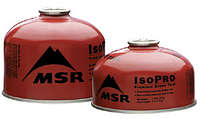IsoPro™ Fuel
Product Description
This premium fuel, an 80/20 blend of isobutane and propane pioneered by MSR, boosts the performance of canister stoves.It outperforms standard butane/propane mixtures and burns clean to reduce soot and clogs.
Features
* Improved Performance:80/20 blend of isobutane and propane delivers superior performance throughout the life of the canister and in colder temperatures.
* Clean-Burning:
Optimal fuel blend results in reduced soot and clogs.
* Recyclable:
Canisters can be recycled. Consult your local recycling center for regulations.
International
In Europe and other countries, outside North America the fuel is saled in a 70/30 blend of butane and propane8oz./227g Canister Fuel
4oz./113g Canister Fuel
Tips
How much fuel should I bring?MSR recommends 4 oz. (114 ml) of liquid fuel per person per day for cooking or 8 oz. (237 ml) of liquid fuel per person per day for melting snow and cooking. An extremely cold trip, like skiing in Antarctica, may require as much as 15 oz. (444 ml) of liquid fuel per person per day.
How long will a canister of MSR IsoPro last?
In general one 8 oz. canister of MSR IsoPro fuel will be sufficient to boil water for two people over four days in summer. Wind, low temperatures and longer cooking times will increase fuel consumption.
Transporting Fuel
Carrying flammable fuel on passenger aircraft in carry-on or checked baggage is forbidden. Before transporting a MSR fuel bottle on an aircraft, safely empty all fuel from the bottle, wash inside with soapy water, rinse thoroughly, air dry, and stow uncapped.
Storing Fuel
Fuel degrades when it contacts air. Store your fuel in an airtight container, such as an MSR fuel bottle.
An Isobutane Seminar
Different fuels in a mixed fuel canister burn at different times over the life of that canister, beginning with high pressure propane and ending with lower pressure fuels like isobutane and n-butane. Canisters containing isobutane, like MSR's IsoPro will consistently perform at a higher level throughout the life of the canister than fuel mixtures containing n-butane. This is because isobutane has a higher vapor pressure than n-butane.
Images
Reviews
Viewing: 1-6 of 6 |
camerona91 - Feb 21, 2007 12:12 am - Hasn't voted
Lights easier
I find it starts better than other fuels in cooler weather (below 5 degrees Celsius). There seems to be a bit of a supply problem in Canada, or at least where I am. One retailer told me that they are taxed more for the larger size and so they only carry the smaller. It is just with the MSR fuel though which comes from Seattle...
Judd97 - Nov 20, 2007 1:58 am - Voted 5/5
Works great
I have always and continue to use this fuel with my MSR Superfly and it has always provided me with dependable, quality service. It's been used in temps ranging from approximately 20 to 90 degrees F.
davebobk47 - Oct 7, 2008 2:32 pm - Voted 4/5
Good fuel
Good fuel although you can't really tell how much is left. Also I've had problems with it not sealing after the first time using the canister which means I have to leave it attached to the stove or all the fuel leaks out. Otherwise it works great.
Alex Wood - Dec 21, 2008 11:35 pm - Hasn't voted
Great Fuel
They last a long time. I have four that are partially full cause I keep thinking that one is going to run out on a hike, so I bring two... So far, each one is half full with well over 100 meals cooked with the Pocket Rocket. Great fuel!
stepho - Mar 14, 2009 11:33 am - Voted 5/5
works well
I haven't ever used it in sub-zero temperatures but it works great in warmer weather. Due to the shape it is very easy to pack.
Viewing: 1-6 of 6 |








tommi - Jan 31, 2007 8:47 am - Voted 5/5
Untitled Review